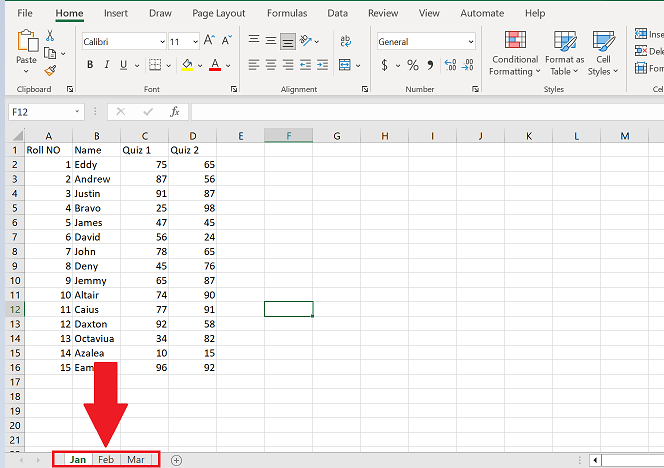Easily Select Sheets in Excel with This Formula

The versatility of Microsoft Excel as a tool for data management and analysis cannot be overstated. One of the key features that make Excel so powerful is its capability to manage multiple sheets within a single workbook. This article will guide you through a hidden gem of Excel functionality: how to easily select sheets using a simple formula, enhancing your efficiency and simplifying your workflow.
The Power of Excel Sheets

Excel workbooks are not just about storing data in rows and columns; they are about organizing complex data sets into different sheets for better readability and analysis. Here’s how using Excel sheets efficiently can benefit you:
- Better Organization: Keep related data separate but accessible.
- Enhanced Analysis: Worksheets allow for more granular analysis of datasets.
- Collaboration: Different team members can work on different sheets simultaneously.

How to Select Sheets Using Formulas

Before diving into the formulas, it’s crucial to understand that Excel has a hidden feature that allows for dynamic sheet selection:
- INDIRECT Function: Allows you to reference cell addresses with text strings.
- Formula Driven: This means you can change sheet references automatically.
The key to utilizing this feature is the use of the INDIRECT function in combination with cell references to select sheets dynamically. Here’s how:
⚠️ Note: Ensure that the worksheet name referenced in the formula exactly matches the name in Excel, including spaces or underscores.
=INDIRECT(“‘” & A1 & “’!B2”)
In this example:
- Cell A1 contains the name of the sheet you want to reference.
- ‘ is used to handle sheet names with spaces or special characters.
- B2 is the cell on the referenced sheet you want to pull data from.
Setting Up Your Excel Workbook for Dynamic Sheet Selection

To harness the full potential of this technique, your Excel workbook must be set up accordingly:
- Create a Reference Sheet: This sheet will contain the names of the other sheets in separate cells.
- Use Formulas: Implement formulas like the one above to pull data dynamically from these sheets.
- Naming Conventions: Keep sheet names consistent to avoid errors.
Here is how you can set up this functionality:
- Create a new sheet for referencing (name it something like “Sheet Manager”).
- List all sheet names in this sheet, e.g., Sheet1, Sheet2, etc.
- Use the INDIRECT function in other sheets or in dashboards to dynamically reference data.
📘 Note: If your sheets contain special characters or spaces in their names, use the full sheet name in quotes within the formula.
Additional Applications

This method isn’t just for pulling data; it has several other applications:
- Data Consolidation: Aggregate data from multiple sheets into a summary sheet.
- Automated Reporting: Create reports that update dynamically as sheets change.
- User-Interactive Dashboards: Allow users to change sheet references by altering a cell value.
Limitations and Tips

While this technique is powerful, it does have its limitations:
- Performance: Large datasets or complex spreadsheets can slow down due to constant recalculation.
- Dependency: If sheet names are changed, formulas can break unless you use a reference system.
Here are some tips to maximize your use:
- Naming Consistency: Use a system for naming sheets to avoid issues with dynamic references.
- Error Handling: Incorporate IFERROR to manage potential errors gracefully.
- Document Formulas: Keep a record of all complex formulas for troubleshooting.
In conclusion, mastering the art of selecting sheets with formulas can significantly enhance your productivity in Excel. By understanding and implementing these techniques, you can automate repetitive tasks, create dynamic reports, and facilitate collaboration among team members. The INDIRECT function, though often overlooked, is a potent tool in your Excel arsenal that can revolutionize how you interact with workbooks. Whether you’re managing financial models, tracking inventory, or any other data-intensive work, the ability to dynamically pull data from different sheets will streamline your workflow and save countless hours.
What does the INDIRECT function do in Excel?

+
The INDIRECT function returns the reference specified by a text string. This text string can be constructed to reference any cell or range within the workbook, including dynamic references to other sheets.
Can you automate data consolidation with sheet selection formulas?

+
Yes, you can automate data consolidation by referencing cell values from multiple sheets using the INDIRECT function, thus creating a dynamic summary sheet.
What happens if the sheet name changes in my formula?

+
If the sheet name changes and it is not correctly referenced in the formula, Excel will return an error, or the formula might pull incorrect data. Ensure that your reference system can handle such changes gracefully.